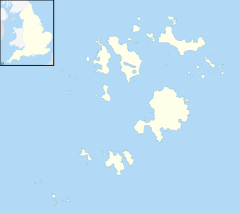Round Island Light, Isles of Scilly

Round Island, Isles of Scilly
|
|
|
Isles of Scilly
|
|
| Location | Round Island Isles of Scilly England |
|---|---|
| Coordinates | 49°58′45″N 6°19′23″W / 49.979033°N 6.323108°WCoordinates: 49°58′45″N 6°19′23″W / 49.979033°N 6.323108°W |
| Year first constructed | 1887 |
| Construction | granite tower |
| Tower shape | cylindrical tower with balcony and lantern |
| Markings / pattern | white tower and lantern |
| Height | 19 metres (62 ft) |
| Focal height | 55 metres (180 ft) |
| Current lens | 360mm revolving optic |
| Intensity | 42,945 candela |
| Range | 18 nautical miles (33 km; 21 mi) |
| Characteristic | Fl W 10s. |
| Fog signal | 4 blasts every 60s. |
| Admiralty number | A0018 |
| NGA number | 0016 |
| ARLHS number | ENG 118 |
| Managing agent | Trinity House |
| Heritage |
Grade II listed building |
|
[]
|
|
Round Island Lighthouse (Cornish: Golowji an Voth, the hump lighthouse), in the Isles of Scilly was designed by William Tregarthen Douglass for Trinity House and completed in 1887. At the time of building it was one of three lights in the Isles of Scilly, the others being the Bishop Rock and St Agnes lighthouse. The light was modernised in 1966, automated in 1987 and the island designated as a Site of Special Scientific Interest (SSSI) in 1995. It is now managed by the Isles of Scilly Wildlife Trust, and except for the maintenance of the Grade 2 listed lighthouse, landing is not allowed.
A cairn or burial chamber was destroyed when the lighthouse was built. Cairns on the Isles of Scilly date back to the Bronze Age and at that time Round Island was probably a peninsula on the northern shore of the main island in the Isles of Scilly. The granite, ashlar, 19 metres (62 ft) tall tower was designed by William Tregarthen Douglass, chief engineer for the Commissioners of Irish Lights and is built on a 35 metres (115 ft) tall mass of Hercynian granite. At the time of building the only access was up a flight of steps cut out of the rock and supplies were taken up the rock face by an aerial hoist. Within the walls of the lighthouse the keepers tended a small vegetable garden, for which the soil was transported to the island.
The light has a focal plane of 180 feet, and originally had an enormous hyperradial optic 4.6 metres (15 ft) high and weighing more than 8 tons. It was built by Chance Brothers & Co of Birmingham and, said at the time, to be ″ .... in relation both to size and character .... the most remarkable works of their kind hitherto achieved.″ A similar optic was installed for the Bishop Rock light the previous year. The optic was replaced in 1966 when the lighthouse was modernised, and again in 1987 when the light was automated. The light now has a 360 millimetres (14 in) optic which emits one white flash every ten seconds, has an intensity of 340,000 candela and a range of 44.5 km (24 nautical miles). The fog signal sounds four blasts every minute. Gusts of winds can be ferocious such as in 1954 when there was continuous gales from 29 November to 16 December. Wind velocities of 177 km/h (110 mph) were recorded at the Bishop Rock where seas raced past the window, and on Round Island the wind gauge was destroyed at 177 km/h.
...
Wikipedia

